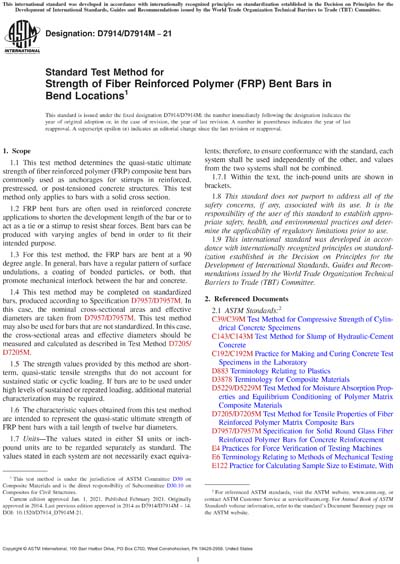Most recent
ASTM D7914/D7914M-21
Standard Test Method for Strength of Fiber Reinforced Polymer (FRP) Bent Bars in Bend Locations
1.1 This test method determines the quasi-static ultimate strength of fiber reinforced polymer (FRP) composite bent bars commonly used as anchorages for stirrups in reinforced, prestressed, or post-tensioned concrete structures. This test method only applies to bars with a solid cross section.
1.2 FRP bent bars are often used in reinforced concrete applications to shorten the development length of the bar or to act as a tie or a stirrup to resist shear forces. Bent bars can be produced with varying angles of bend in order to fit their intended purpose.
1.3 For this test method, the FRP bars are bent at a 90 degree angle. In general, bars have a regular pattern of surface undulations, a coating of bonded particles, or both, that promote mechanical interlock between the bar and concrete.
1.4 This test method may be completed on standardized bars, produced according to Specification D7957/D7957M. In this case, the nominal cross-sectional areas and effective diameters are taken from D7957/D7957M. This test method may also be used for bars that are not standardized. In this case, the cross-sectional areas and effective diameters should be measured and calculated as described in Test Method D7205/D7205M.
1.5 The strength values provided by this method are short-term, quasi-static tensile strengths that do not account for sustained static or cyclic loading. If bars are to be used under high levels of sustained or repeated loading, additional material characterization may be required.
1.6 The characteristic values obtained from this test method are intended to represent the quasi-static ultimate strength of FRP bent bars with a tail length of twelve bar diameters.
1.7 Units—The values stated in either SI units or inch-pound units are to be regarded separately as standard. The values stated in each system are not necessarily exact equivalents; therefore, to ensure conformance with the standard, each system shall be used independently of the other, and values from the two systems shall not be combined.
1.7.1 Within the text, the inch-pound units are shown in brackets.
1.8 This standard does not purport to address all of the safety concerns, if any, associated with its use. It is the responsibility of the user of this standard to establish appropriate safety, health, and environmental practices and determine the applicability of regulatory limitations prior to use.
1.9 This international standard was developed in accordance with internationally recognized principles on standardization established in the Decision on Principles for the Development of International Standards, Guides and Recommendations issued by the World Trade Organization Technical Barriers to Trade (TBT) Committee.
Content Provider
ASTM International [astm]






